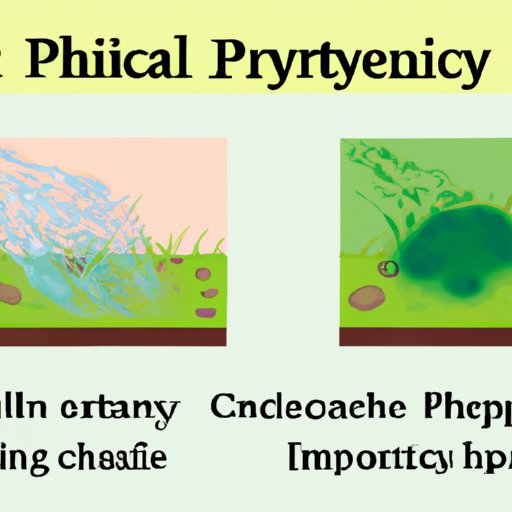
Introduction
Physical changes and chemical changes are two fundamental concepts in science that are often encountered in our daily lives. While they may and often do coexist, it is vital to understand the fundamental differences between the two types of changes. By knowing how to differentiate them, we can gain a better understanding of the phenomena we experience and are better equipped to manage them. This article aims to define and explore the differences between physical and chemical changes, as well as highlight some of their real-life applications, educational value, and environmental impact.
Understanding the Basics: Physical Changes vs. Chemical Changes
The term “physical change” is used to refer to a change in the physical properties of a substance without affecting its composition. It occurs when the substance changes its form, but not its chemical identity. Physical changes do not involve transformations in the molecular or chemical structure of the substance. Examples of physical changes include melting, freezing, boiling, dissolving, and evaporation.
A “chemical change,” on the other hand, is a more radical and permanent change that alters the chemical composition of the substance. In a chemical change, the molecules of the substances involved are rearranged in such a way that atoms bond differently. These changes are not reversible, and the resulting substance cannot revert to its original form. The formation of new substances with different properties and characteristics is one of the most noticeable indications of a chemical change. Examples of chemical changes include combustion, fermentation, rusting, and electrolysis of water.
A Closer Look: Examining the Properties of Physical and Chemical Changes
The driving force behind physical changes is a change in temperature, pressure, and physical state (via solid-state changes). Physical changes typically do not involve a change in the energy of the substance and do not involve the shedding or absorption of energy such as light energy and heat energy. One of the most noticeable examples of physical changes is melting. For instance, melting an ice block does not change the chemical composition of the substance, nor is there any chemical reaction happening.
Chemical changes occur when the substance’s molecular structure is transformed, often as a result of a chemical reaction. In a chemical reaction, heat, light, energy, and other components may be involved or given off. It results in the formation of new compounds and molecules with altered properties. One of the most noticeable examples of a chemical change is rusting iron. Rusting iron is a chemical process that involves the formation of a new substance and is irreversible. The energy transferred will either get absorbed or released in the process.
Real-Life Applications: Illustrating Physical and Chemical Changes in Everyday Life
Physical and chemical changes are ubiquitous in daily life. For instance, consider cooking. We subject food to physical and chemical changes regularly when we cook. When we boil water and add pasta, the transformation of the pasta from hard to soft is a physical change. However, when we fry oil and vegetables, it reacts with the oil to create different chemical compounds, which is a chemical change. Also, consider rusting. It is a chemical change that results in the demolition of buildings, bridges, and other structures.
Education Spotlight: How Physical and Chemical Changes are Presented in Different Learning Levels
Schools and educational programs present physical and chemical changes in different learning levels. In elementary schools, children are taught about changes in state (solid, liquid, and gas) and what cause the changes. This lays the groundwork for the concept of physical changes. In high school, subjects like stoichiometry, balancing equations and other concepts are discussed. By the time students are in college and studying chemistry, they are well-versed in the basics of chemistry and ready to work with more complex ideas like kinetics and quantum theory.
Environmental Impact: Analyzing the Effects of Physical and Chemical Changes on Our World
The effects of physical and chemical changes can be profound and long-lasting. Chemical changes, in particular, can cause environmental damage. Consider the effects of pollutants on marine life. Physical changes, such as erosion and weathering, can also have lasting effects on the environment. Human activity and disasters, such as oil spills and the release of toxic chemicals, can result in environmental damage caused by chemical changes.
Conclusion
Physical changes and chemical changes are two concepts that are fundamental in science and encountered on a daily basis. Understanding the differences between the two types of changes can help us better manage the phenomena we experience and protect the environment. Physical changes are changes in physical properties without affecting the composition, while chemical changes result in permanent alterations to the substance’s chemical composition. We rely on physical and chemical changes for many applications, such as cooking, hygiene, or construction. We must also note that their transformative nature can have profound and long-lasting environmental effects. The more we know about physical and chemical changes, the better informed we are, and the better equipped to deal with any issues that may arise.




